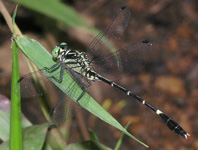Abstract
Apollophanes has a wide distribution, with some species in Asia and most of the species recorded from North and Central America (World Spider Catalog 2016). New species described from the Galapagos Islands by Baert (2013) have extended the genus range to South America. According to Dondale and Redner (1975) and Dondale and Redner (1978), the species of Apollophanes have a moderately low prosoma, usually of yellow to orange-brown color and with black or brown spots on the lateral margins. The posterior eyes distances are equally spaced and the legs are long, slender and speckled with dark spots, with leg I usually being longer than IV (characteristic observed only in the male exemplar of the new species). The opisthosoma has a conspicuous heart mark, dark longitudinal spots on the lateral margins and a pale ventral region with purple spots. According to Dondale and Redner (1975) and Logunov (1996), Apollophanes shares some features with species of Cleocnemis, Thanatus and Tibellus, e.g. the shape and coloration patterns of the dorsal shield of the prosoma, as well as the slender legs with dark spots. Apollophanes can be distinguished from Cleocnemis by the presence of two tibial apophyses (ventral and retrolateral) and by the size of the copulatory ducts openings that are long slits that reach the posterior margin of epigastric furrow in Apollophanes, while in Cleocnemis the openings are shorter and situated in central region of the median septum (Dondale & Redner 1975). Apollophanes differs from Thanatus by the presence of macrosetae on the prolateral region of the metatarsus, and differs from Tibellus by the size of leg IV, that is longer than leg I (Dondale & Redner 1975).
References
Baert, L. (2013) The Thomisidae and Philodromidae (Arachnida: Araneae) of the Galápagos Islands (Ecuador). European Journal of Taxonomy, 43, 1–23.
Dondale, C.D. & Redner, J.H. (1975) Revision of the spider genus Apollophanes (Araneida: Thomisidae). The Canadian Entomologist, 107, 1175–1192.
http://dx.doi.org/10.4039/Ent1071175-11Dondale, C.D. & Redner, J.H. (1978) The insects and arachnids of Canada, Part 5. The crab spiders of Canada and Alaska. Araneae: Philodromidae and Thomisidae. Research Branch Canada Department of Agriculture Publication, 1663, 1–255.
Logonov, D.V. (1996) A critical review of the spider genera Apollophanes O. P.-Cambridge, 1898 and Thanatus C.L. Koch, 1837 in North Asia (Araneae, Philodromidae). Revue Arachnologique, 11, 133–202.
Muster, C. (2009) Phylogenetic relationships within Philodromidae, with a taxonomic revision of Philodromus subgenus Artanes in the western Palearctic (Arachnida: Araneae). Invertebrate Systematics, 23, 135–169.
http://dx.doi.org/10.1071/IS08044World Spider Catalog (2016) World Spider Catalog. Version 17.0. Natural History Museum Bern. Available from: http://wsc.nmbe.ch (accessed 6 March 2016)

